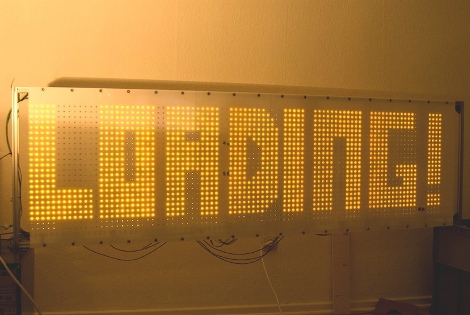
The Revision 2011 demo party that brought us” table for two” a little while ago along with some super demos for PC’s, retro, and state of the art, has also brought us the Photon Banner(google translate). The Photon Banner is a 96X24 led matrix that was made with (of course) 2304 5mm leds, and a atmega 644 clocked at 20MHz.
The end result is a 192cm X 48cm display area that uses the single micro controller, that has been beefed up with 2 megs of SPI flash memory, 6 driver boards, and took about a month just to construct. The software to drive the show took another 15 days, and it is pretty darn impressive.
The website above contains a bunch of photos, parts lists, and schematics. Before you go running off you should join us after the break for a couple of quick videos.
[youtube=http://www.youtube.com/watch?v=XgEYBqEIDEY&w=450]
[youtube=http://www.youtube.com/watch?v=LWY_jnurgo0&feature=player_embedded&w=450]















May I be the first to say HOLY CRAP THAT’S AWEXOME! I’ll take 3, built please ;-)
Agreed.
Win overflow.
sexy
must have the patience of a saint for that many leds. looks amazing!
Looking at the physical assembly alongside the software capabilities – I can only say this is a top-rate implementation of the highest professsional quality in development and prototyping.
Excellent!
That is super impressive. Nice work!
AMIGAAAA@@!!!!
So, if you formated a display at 16:9 and used rgb leds…..
things that make you go hmmmmmm
Too bad no source published…would be great to look at how he pulled off all of that animation. From reading the description, it looks like all of the graphics processing is being done on an external PC with a C# program. Would love to see how he is exactly doing all of the software side!
Amazing, but why are the brightness levels so uneven?
O-OH! NERDGASM!!!
@adam,
My guess is they ebayed a package of 1000 leds for cheap (didnt read the article yet) so there are going to naturally be some issues with manufacturing inconsistencies.
#anyone
Wonder if you could use an RS485 bus to chain these together. I realize they are using shift registers but it seems like it would take some effort to shift across 2 or more of these screens.
@adam
Either as suggested cheap LEDs or they weren’t extremely careful and used directional LEDs. The dim spots are ones that are pointing slightly the wrong way.
If it’s a cheap LED issue and you had brightness control on each, you could use a camera and some feedback control to keep them all at the same level. You’d probably want to store an offset table in memory and apply that brightness offset to switch on operation.
That would be tricky with this beast which is probably only an on/off per LED.
To fix the directional LED issue, put a diffuser in front of each LED.
I don’t really get the fascination with LED arrays. This blog really seems to have a fetish for them. It’s kinda neat, I guess, but I’m not super excited by seeing yet another version of what was hanging in my elementary school cafeteria showing menus and coming school events.
@BobSmith
here here
@BobSmit
Because they have a lot of visual impact, especially to people who are not really geeky and wouldn’t find DIY projects that interesting. A hack doesn’t have to be “high tech” for it to be cool. There are also a lot of projects with Nixie tubes, do you hate those too?
Also, there are a lot of unique challenges when it comes to writing software for LED matrices, especially when you’re writing some kind of animation engine. I built an 8x8x8 LED cube once and the software turned out to be extremely complicated and fun. I don’t see why you have to be such a downer…
The LEDs are cheap china made ones. They come with an opening angle of 20deg, which is crap for a matrix screen, but we used them anyway. Differences in intensity are not visible between each individual LED. However, one batch we received had widely different colors going from bright yellow to orange. We use that batch for a prototype, but not for the final Photonenbanner.
Some LEDs are not fitted perfectly rectangular to the surface. This, the 20deg angle, and the fact that the camera was pretty close makes it look like the LEDs have different intensities in the video.